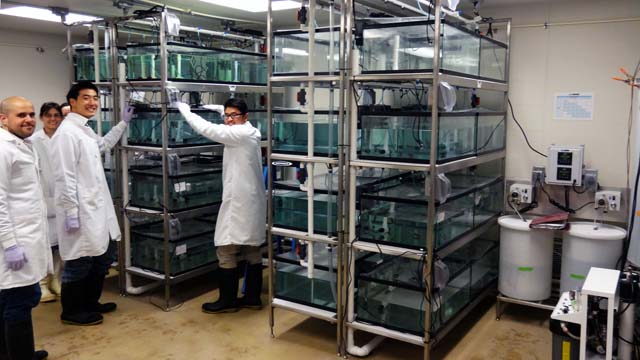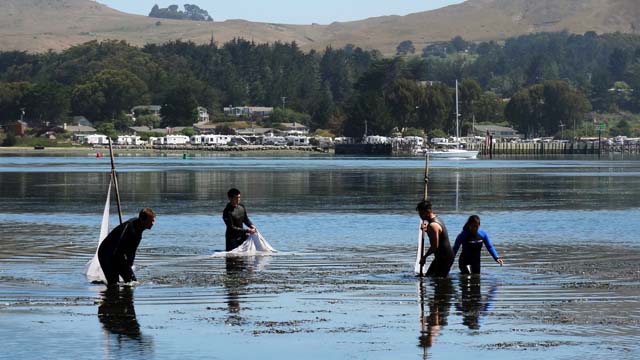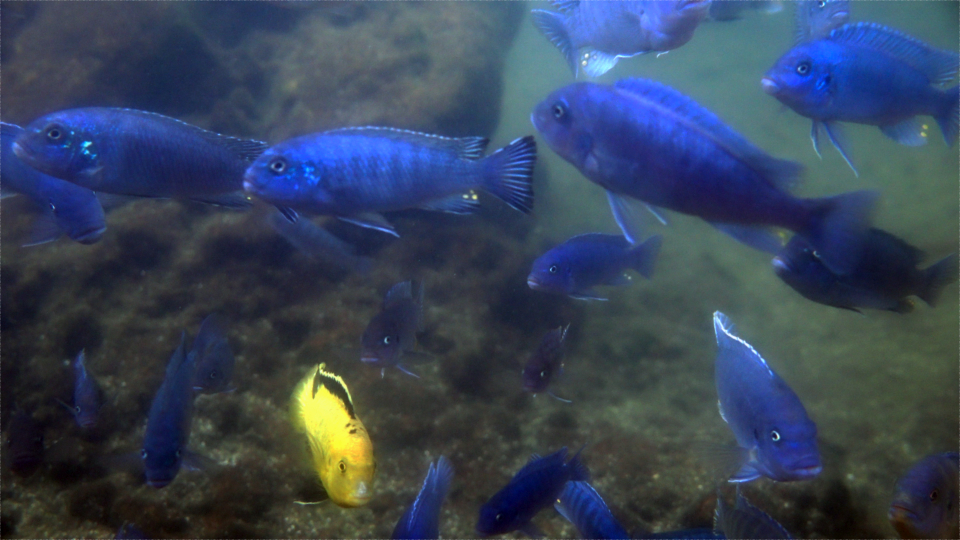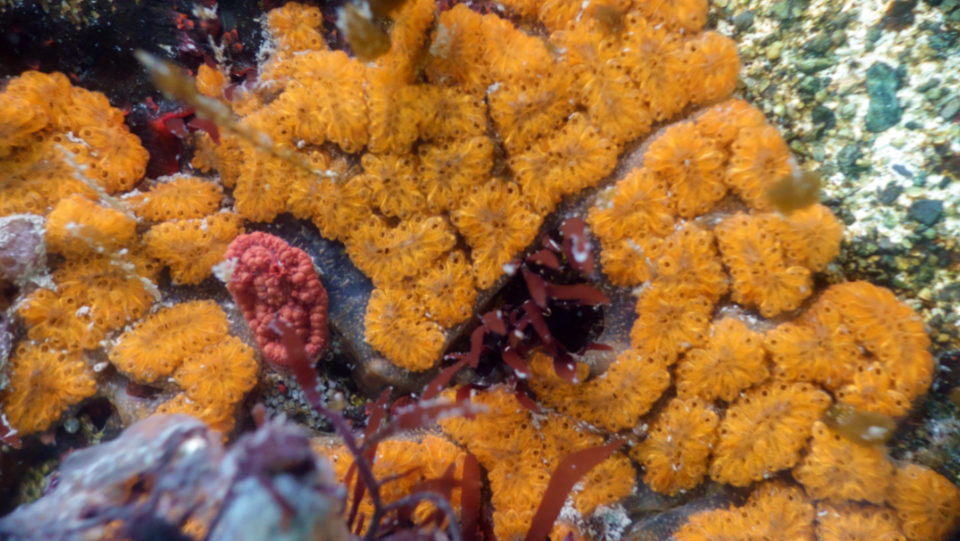|
 Stress-induced evolution (→SIE) of fish and marine invertebrates Stress-induced evolution (→SIE) of fish and marine invertebrates
We investigate the effects of stress-induced genomic variation on molecular phenotypes (proteomes) and their consequences for evolution. Effects of osmotic stress on aquatic organisms and their cells are of particular interest. To dissect and understand SIE mechanisms we use biological mass spectrometry, targeted proteomics (Skyline and PanoramaWeb), integrative systems/ network modeling, imaging, and synthetic biology approaches. Key questions of interest are: What is the role of stress-induced evolution (SIE) for biodiversity? What are the underlying molecular mechanisms of SIE? How do cells and species evolve in stressful environments?
|
| Current Lab Members |
 |
Brenda Luu, Junior Specialist |
 |
Bryce Parker, Lab. Assistant |
 |
Meranda Corona, PhD student, GGE |
 |
Monica Urias, PhD student, GGE |
 |
Dawn Wang, Postdoc/Visiting Faculty |
 |
Jens Hamar, PD Fellow |
 |
Valerie Weizhen Dong, PhD student, ABG |
 |
Maxime Lepretre, PD Fellow |
 |
Dietmar Kültz, Professor of Physiological Genomics (PI) |
|
|
|
| Undergraduate Interns: Kathleen Petcu, Isabel Enriquez, Rachel Hong, Kayla Lee, Karen Guo, Charlise Cambronero, Hannah Cohen, Yanyu Zhang, Sarah Gibides, Justine Weiss, Anh Nguyen, Ella McCarthy |
|
  The concept of SIE is based on the realization that macromolecular damage is the common denominator of cellular stress (Kültz, 2005). SIE is also known as stress-induced evolutionary innovation (Wagner et al., 2019). It represents an exciting, recently discovered mechanism of evolution, which explains biological phenomena that reach beyond the theoretical framework of the Modern synthesis of Neo-Darwinism (Heng, 2019; Noble, 2021). The concept of SIE is based on the realization that macromolecular damage is the common denominator of cellular stress (Kültz, 2005). SIE is also known as stress-induced evolutionary innovation (Wagner et al., 2019). It represents an exciting, recently discovered mechanism of evolution, which explains biological phenomena that reach beyond the theoretical framework of the Modern synthesis of Neo-Darwinism (Heng, 2019; Noble, 2021). |
 Osmosensing and stress-induced evolution of euryhaline cichlids. Tilapia are African cichlids that represent a classical model for evolutionary biology. They have radiated into many different ecological niches forming almost 2000 species within a relatively short time. We study several tilapia species that have evolved extreme salinity and pH tolerance and compare them to congeners that have much lower tolerances. The emphasis is on discovering, understanding, and manipulating mechanisms of osmosensing that control gene expression patterns, proteome dynamics, and organismal phenotypes in changing environmental contexts. Salinity, pH, and temperature are key environmental parameters that impose significant stress on aquatic organisms due to anthropogenic acceleration of climate change. Therefore, our research helps in understanding and predicting consequences of climate change on fish populations and species diversity. By focusing on stress-induced evolution, we aim to better understand the time frame in which evolution can occur and whether the rate of evolution differs in eury- vs. steno-topic species. After carps, tilapias are the second most important group of aquaculture fish worldwide. Many tilapias are highly environmentally stress tolerant with the exception of cold tolerance. We are interested in how tilapia cold and heat tolerance are genetically determined and how these traits interact with other traits that are important for aquaculture (growth, salinity tolerance, etc.). Osmosensing and stress-induced evolution of euryhaline cichlids. Tilapia are African cichlids that represent a classical model for evolutionary biology. They have radiated into many different ecological niches forming almost 2000 species within a relatively short time. We study several tilapia species that have evolved extreme salinity and pH tolerance and compare them to congeners that have much lower tolerances. The emphasis is on discovering, understanding, and manipulating mechanisms of osmosensing that control gene expression patterns, proteome dynamics, and organismal phenotypes in changing environmental contexts. Salinity, pH, and temperature are key environmental parameters that impose significant stress on aquatic organisms due to anthropogenic acceleration of climate change. Therefore, our research helps in understanding and predicting consequences of climate change on fish populations and species diversity. By focusing on stress-induced evolution, we aim to better understand the time frame in which evolution can occur and whether the rate of evolution differs in eury- vs. steno-topic species. After carps, tilapias are the second most important group of aquaculture fish worldwide. Many tilapias are highly environmentally stress tolerant with the exception of cold tolerance. We are interested in how tilapia cold and heat tolerance are genetically determined and how these traits interact with other traits that are important for aquaculture (growth, salinity tolerance, etc.). |
 Stress-induced evolution of botryllid tunicates. Colonial tunicates including Botryllus schlosseri and Botrylloides spp. are capable of rapid cell division, whole body regeneration, and high tolerance of diverse environmental conditions. Their high stress tolerance and rapid proliferation makes them invasive species in many parts of the world, including California. Our research on tunicates aims to reveal basic mechanisms of stress-induced evolution (SIE) and mechanisms that constrain SIE and somatic cell immortalization. Unlike for vertebrates (including humans) and terrestrial invertebrates (insects, etc.), immortalization of marine invertebrate cells and generation of corresponding cell lines has not been achieved. Using DIA quantitative proteomics (SWATH-MS) we are studying the biochemical networks that are altered in botryllid tunicates when they are taken from an in situ tissue context into primary culture. Moreover, we utilize stress to generate genetic variation in primary tunicate cell cultures and accelerate evolution to increase the likelihood of immortalization. This research can be leveraged to design conceptually novel strategies for counteracting tumorigenesis to protect people from proliferative diseases such as cancer. Moreover, generation of marine invertebrate cell lines and understanding how environmental stress governs their proliferation and differentiation supports the development of cell-based seafood. Stress-induced evolution of botryllid tunicates. Colonial tunicates including Botryllus schlosseri and Botrylloides spp. are capable of rapid cell division, whole body regeneration, and high tolerance of diverse environmental conditions. Their high stress tolerance and rapid proliferation makes them invasive species in many parts of the world, including California. Our research on tunicates aims to reveal basic mechanisms of stress-induced evolution (SIE) and mechanisms that constrain SIE and somatic cell immortalization. Unlike for vertebrates (including humans) and terrestrial invertebrates (insects, etc.), immortalization of marine invertebrate cells and generation of corresponding cell lines has not been achieved. Using DIA quantitative proteomics (SWATH-MS) we are studying the biochemical networks that are altered in botryllid tunicates when they are taken from an in situ tissue context into primary culture. Moreover, we utilize stress to generate genetic variation in primary tunicate cell cultures and accelerate evolution to increase the likelihood of immortalization. This research can be leveraged to design conceptually novel strategies for counteracting tumorigenesis to protect people from proliferative diseases such as cancer. Moreover, generation of marine invertebrate cell lines and understanding how environmental stress governs their proliferation and differentiation supports the development of cell-based seafood. |
| Photos by Kültz Laboratory - ask for permission to reproduce |

 The concept of SIE is based on the realization that macromolecular damage is the common denominator of cellular stress (Kültz, 2005). SIE is also known as stress-induced evolutionary innovation (Wagner et al., 2019). It represents an exciting, recently discovered mechanism of evolution, which explains biological phenomena that reach beyond the theoretical framework of the Modern synthesis of Neo-Darwinism (Heng, 2019; Noble, 2021).
The concept of SIE is based on the realization that macromolecular damage is the common denominator of cellular stress (Kültz, 2005). SIE is also known as stress-induced evolutionary innovation (Wagner et al., 2019). It represents an exciting, recently discovered mechanism of evolution, which explains biological phenomena that reach beyond the theoretical framework of the Modern synthesis of Neo-Darwinism (Heng, 2019; Noble, 2021). Osmosensing and stress-induced evolution of euryhaline cichlids. Tilapia are African cichlids that represent a classical model for evolutionary biology. They have radiated into many different ecological niches forming almost 2000 species within a relatively short time. We study several tilapia species that have evolved extreme salinity and pH tolerance and compare them to congeners that have much lower tolerances. The emphasis is on discovering, understanding, and manipulating mechanisms of osmosensing that control gene expression patterns, proteome dynamics, and organismal phenotypes in changing environmental contexts. Salinity, pH, and temperature are key environmental parameters that impose significant stress on aquatic organisms due to anthropogenic acceleration of climate change. Therefore, our research helps in understanding and predicting consequences of climate change on fish populations and species diversity. By focusing on stress-induced evolution, we aim to better understand the time frame in which evolution can occur and whether the rate of evolution differs in eury- vs. steno-topic species. After carps, tilapias are the second most important group of aquaculture fish worldwide. Many tilapias are highly environmentally stress tolerant with the exception of cold tolerance. We are interested in how tilapia cold and heat tolerance are genetically determined and how these traits interact with other traits that are important for aquaculture (growth, salinity tolerance, etc.).
Osmosensing and stress-induced evolution of euryhaline cichlids. Tilapia are African cichlids that represent a classical model for evolutionary biology. They have radiated into many different ecological niches forming almost 2000 species within a relatively short time. We study several tilapia species that have evolved extreme salinity and pH tolerance and compare them to congeners that have much lower tolerances. The emphasis is on discovering, understanding, and manipulating mechanisms of osmosensing that control gene expression patterns, proteome dynamics, and organismal phenotypes in changing environmental contexts. Salinity, pH, and temperature are key environmental parameters that impose significant stress on aquatic organisms due to anthropogenic acceleration of climate change. Therefore, our research helps in understanding and predicting consequences of climate change on fish populations and species diversity. By focusing on stress-induced evolution, we aim to better understand the time frame in which evolution can occur and whether the rate of evolution differs in eury- vs. steno-topic species. After carps, tilapias are the second most important group of aquaculture fish worldwide. Many tilapias are highly environmentally stress tolerant with the exception of cold tolerance. We are interested in how tilapia cold and heat tolerance are genetically determined and how these traits interact with other traits that are important for aquaculture (growth, salinity tolerance, etc.). Stress-induced evolution of botryllid tunicates. Colonial tunicates including Botryllus schlosseri and Botrylloides spp. are capable of rapid cell division, whole body regeneration, and high tolerance of diverse environmental conditions. Their high stress tolerance and rapid proliferation makes them invasive species in many parts of the world, including California. Our research on tunicates aims to reveal basic mechanisms of stress-induced evolution (SIE) and mechanisms that constrain SIE and somatic cell immortalization. Unlike for vertebrates (including humans) and terrestrial invertebrates (insects, etc.), immortalization of marine invertebrate cells and generation of corresponding cell lines has not been achieved. Using DIA quantitative proteomics (SWATH-MS) we are studying the biochemical networks that are altered in botryllid tunicates when they are taken from an in situ tissue context into primary culture. Moreover, we utilize stress to generate genetic variation in primary tunicate cell cultures and accelerate evolution to increase the likelihood of immortalization. This research can be leveraged to design conceptually novel strategies for counteracting tumorigenesis to protect people from proliferative diseases such as cancer. Moreover, generation of marine invertebrate cell lines and understanding how environmental stress governs their proliferation and differentiation supports the development of cell-based seafood.
Stress-induced evolution of botryllid tunicates. Colonial tunicates including Botryllus schlosseri and Botrylloides spp. are capable of rapid cell division, whole body regeneration, and high tolerance of diverse environmental conditions. Their high stress tolerance and rapid proliferation makes them invasive species in many parts of the world, including California. Our research on tunicates aims to reveal basic mechanisms of stress-induced evolution (SIE) and mechanisms that constrain SIE and somatic cell immortalization. Unlike for vertebrates (including humans) and terrestrial invertebrates (insects, etc.), immortalization of marine invertebrate cells and generation of corresponding cell lines has not been achieved. Using DIA quantitative proteomics (SWATH-MS) we are studying the biochemical networks that are altered in botryllid tunicates when they are taken from an in situ tissue context into primary culture. Moreover, we utilize stress to generate genetic variation in primary tunicate cell cultures and accelerate evolution to increase the likelihood of immortalization. This research can be leveraged to design conceptually novel strategies for counteracting tumorigenesis to protect people from proliferative diseases such as cancer. Moreover, generation of marine invertebrate cell lines and understanding how environmental stress governs their proliferation and differentiation supports the development of cell-based seafood.